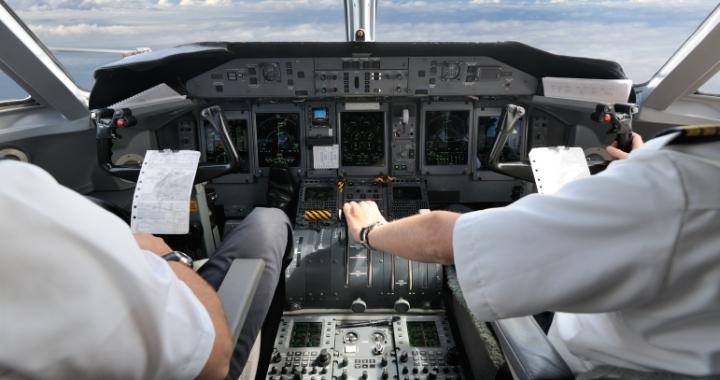Long-haul flights, for passengers, are often an opportunity to settle into a cozy seat, watch movies, enjoy in-flight meals, and perhaps catch up on sleep. It’s an experience defined by comfort, entertainment, and anticipation. But what about the other side of the story—the perspective from the flight deck?
Passengers rarely get a glimpse into the meticulously orchestrated activities happening in the cockpit. While the aircraft soars after it reaches cruising altitude, there’s a complex world of responsibilities and tasks that pilots shoulder to ensure a safe and smooth journey.
Today, we’re dedicating this post to take a look at what pilots really do during those long, transcontinental flights. Beyond the moment the cabin doors close and the plane takes off, the flight crew embarks on a journey of its own, where meticulous planning, vigilant monitoring, and expert decision-making are the norm. Join us as we explore the intricacies of life on the flight deck during those extended hours at 35,000 feet and beyond.

What Do Pilots Do On Long Flights?
Monitoring Weather Systems
When the doors close and the aircraft taxis for takeoff, pilots start their journey long before passengers even notice. One of their primary tasks is monitoring weather systems. Weather can change rapidly, and pilots rely on real-time data from air traffic control and onboard radar to make informed decisions.
Pilots track weather patterns, turbulence, storms, and other meteorological factors that might affect the flight. This information helps them adjust the flight paths and altitude to ensure a smoother and safer ride for everyone on board.
Checking Fuel Levels
Flying a large aircraft across continents requires significant fuel reserves. Pilots monitor the fuel tanks meticulously to ensure there’s enough to reach the destination and handle unexpected situations. Fuel tanks are divided, allowing the crew to balance the load as needed for optimal performance.
They consider factors like headwinds, altitude changes, and diversions. In-flight refueling is rarely an option, so fuel management is critical to avoid running out of fuel mid-flight. Some private jets are also designed to go long distances without refueling.
Contingency Planning
Contingency planning is the backbone of every long-haul flight. Pilots consider various “what-ifs,” such as medical emergencies, equipment failures, or unfavorable weather conditions.
They identify alternate airports and diversion routes, ensuring they have a plan for any unexpected situation. This proactive approach is vital to passenger safety and peace of mind.

Taking Turns Sleeping
Long flights can span many hours or even overnight. To combat fatigue, flight crews take turns resting. This practice is essential for maintaining alertness. With more than one pilot onboard, it’s easier to take turns in management and testing mid-flight.
Airline regulations and policies also dictate strict rest and duty periods to ensure that pilots are well-rested and fit to fly. Ensuring they are mentally and physically prepared is paramount to safety. Are you a pilot who values your sleep on board? There’s no better option for in-flight sleep than Jetbed.
Autopilot and Flight Management
While the auto-pilot may handle some aspects of the flight, pilots are far from idle. They program the autopilot to follow the flight plan, but they remain actively engaged in managing the flight.
Pilots continually oversee the flight management system, making adjustments as needed to optimize fuel efficiency, stay on course, and adapt to changing conditions. Their expertise is crucial, especially during takeoff and landing.
Flying the Plane
Ultimately, the responsibility of flying the plane rests with the pilots. They handle takeoff, climb to cruising altitude, navigate the flight path, and oversee the descent and landing.
Even with advanced automation, pilots are the ones who make decisions and take control when needed, ensuring a smooth and safe journey for everyone on board.
Entertainment and Relaxation
During periods of stability, pilots can also take short breaks to rest, eat, and relax. They ensure one crew member remains vigilant at all times. This is why there is usually more than one pilot flying a plane alongside other duties.
These moments of respite allow them to recharge, watch movies, or engage in leisure activities while ensuring the flight’s overall safety and well-being.
Note: Most long-haul flights are operated by a crew of two or more pilots. This includes a Captain (or Pilot-in-Command) and a First Officer (or Co-Pilot). On exceptionally long journeys, additional relief or reserve pilots may also be on board. The dynamics among the flight crew are essential for seamless coordination and the safe completion of the flight. This is how many pilots fly a plane together and how different pilots can do different things on long flights.

Pilots are crucial to the safety and success of long flights.
Long-haul flights are a testament to the professionalism and dedication of pilots. Their tasks encompass a wide range of responsibilities, ensuring passenger safety, comfort, and a successful journey. The next time you’re cruising at 35,000 feet and watching a movie, remember the flight crew in the cockpit, working tirelessly to make your voyage enjoyable and secure.
For more answers to questions related to your private jet ownership, consult our blog. And, if you’re looking for an easy and convenient tool that will help you and your crew avoid flight fatigue, explore our fleet of JetBeds to find the one that best fits your aircraft.

